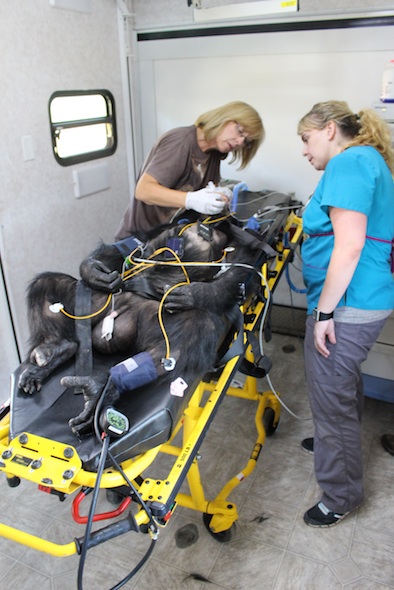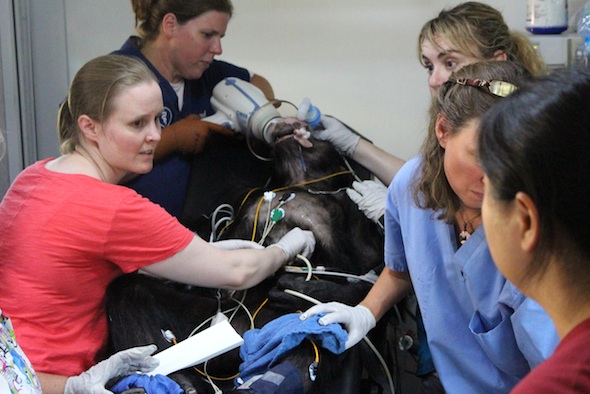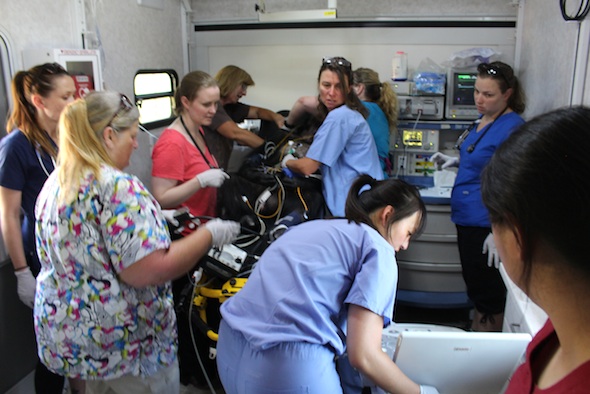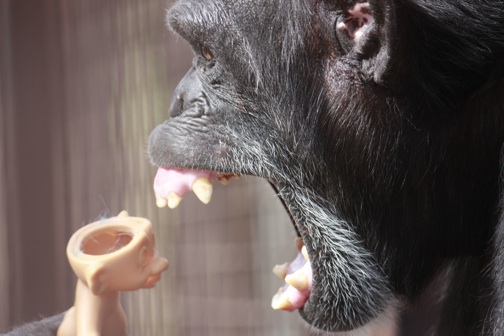Recently, Burrito fractured a canine tooth. We don’t know how it happened exactly – in fact, we only became aware of the injury when we noticed it pointing straight out of his mouth, perpendicular to his other teeth. As with other significant injuries, we began by administering oral antibiotics and pain relievers and arranged for our local veterinarian, Dr. Zamzow, to come take a look. Dr. Zamzow then consulted with Dr. Mensching, also a veterinarian and a member of our board of directors, and Dr. Bezner from Save the Chimps, to come up with a plan to deal with Mr. B’s broken tooth.
If you don’t know this already, I should point out that chimpanzees are remarkably tough. Believe it or not, Burrito never missed a meal, and didn’t even seem to favor that side of his mouth when chewing. It’s really hard to appreciate how stoic chimps can be until you witness it yourself.
Despite his own lack of concern about the injury, a broken tooth can present serious risks for more severe pain and infection down the road, particularly the canines which are large and deeply rooted, so we decided that it would have to be repaired or extracted by a veterinary dentist. But as you may know, Burrito is already being treated for symptoms of heart disease, and that makes decisions about medical interventions a bit more complicated due to the risks of anesthesia. But when an intervention is required, for whatever reason, it presents an opportunity to learn more about his overall health, so we gathered an amazing group of people to help with Burrito’s treatment. And it was all made possible because you helped us build an onsite veterinary clinic.
Before we can make any decisions about how the treat the tooth, we need x-rays. Yesterday, two vet techs from Valley Veterinary Hospital in Ellensburg came to the sanctuary with digital radiography equipment to get pictures of his teeth and jaw. These x-rays will be shared with a board certified veterinary dentist, who has agreed to come to our clinic to treat Burrito, whatever that treatment may be. And because of our concerns about Burrito’s heart, we were grateful to have the assistance of a huge team of veterinary cardiologists, anesthesiologists, residents, and vet students from the Washington State University Veterinary Teaching Hospital, all led by Cardiologist Dr. Lynn Nelson.
After receiving anesthetic injections inside the chimp house, Burrito was wheeled to the mobile clinic where he was intubated and placed onto gas anesthesia for the procedures. The anesthesiologists were able to ensure his safety by monitoring his airway gases and reading his vitals using ECG, blood pressure, temperature, and pulse ox equipment. Dr. Zamzow drew blood for CBC and chem profiles and obtained an urine sample.
With such a huge group of people, teams worked in shifts as much as possible.
But the clinic turned out to fit more people than we had expected. Technicians obtained dental x-rays while the cardiology team began the echocardiogram.
This imaging of Burrito’s heart will help us evaluate his initial diagnosis and may potentially provide avenues for better treatment. It will also help us determine how well he might handle the anesthesia required for a longer dental procedure. We will share the information we obtain with the Great Ape Heart Project to help improve the lives of other captive chimpanzees.
When the tests were complete, Burrito was placed back inside into one of the front rooms to recover from the anesthesia. The girls had to wait outside in the greenhouse until he was ready to deal with all of their excitement.
After a few hours of rest, he was ready for visitors on the other side of the caging. Jody and Foxie were particularly concerned about their buddy, but eventually all of the girls came to groom him through the bars. For his safety, he was not allowed to return to the group until he was 100% recovered from the anesthesia.
Both the general and injectable anesthesia can upset the stomach and make you feel all worn out, so Burrito took an additional day to lounge around by himself, waited on at all times by his staff of caregivers.
With the help of some anti-nausea medicine, he was feeling good enough this evening to join the gang for a dinner forage on the hill.
In the coming weeks we will learn more about Burrito’s health from these tests, and the veterinary dentist will be able to decide the best coarse of action based on his x-rays and what the other tests tell us about his ability to tolerate prolonged anesthesia.
Exams like this aren’t easy on a chimp, and they’re pretty tough on the people who care about them too. We owe a huge debt of gratitude to Dr. Zamzow, Dr. Mensching, Dr. Bezner, Valley Veterinary Hospital, and the WSU Veterinary Teaching Hospital for providing the best care a chimp could ask for. And to everyone who helped us build and equip our onsite clinic: You made it possible for him to receive this level of care. And I know you would agree that this guy deserves nothing less.














